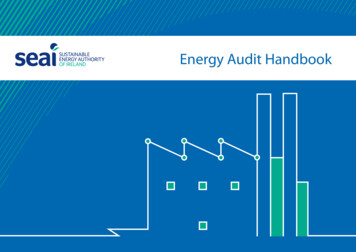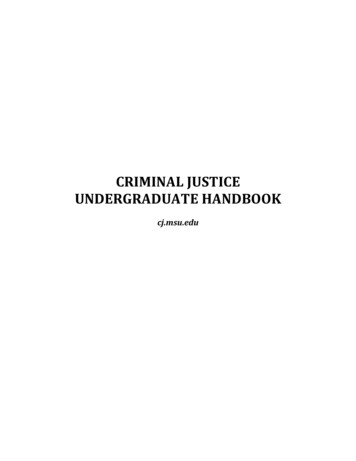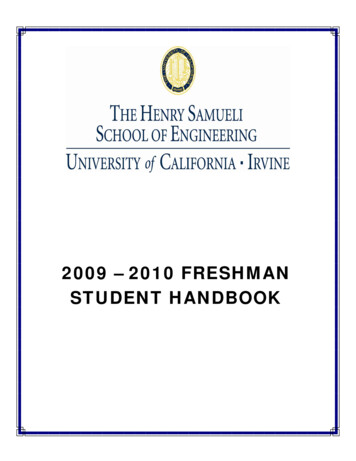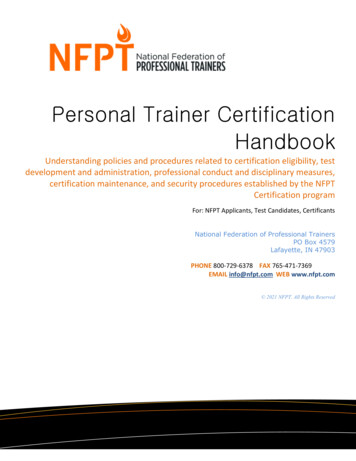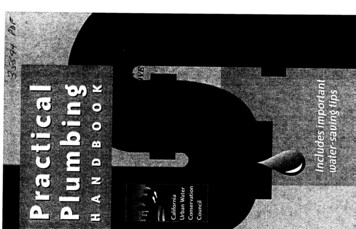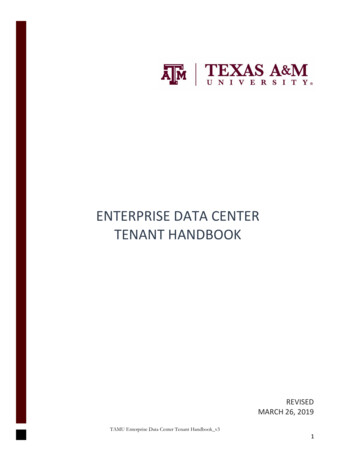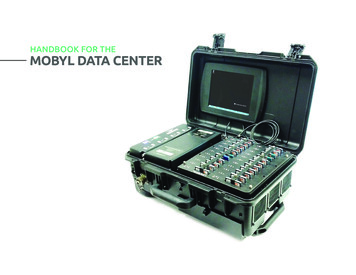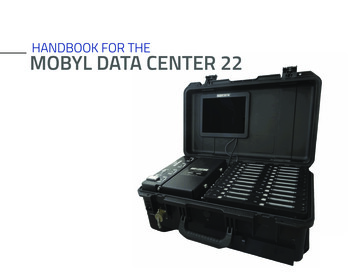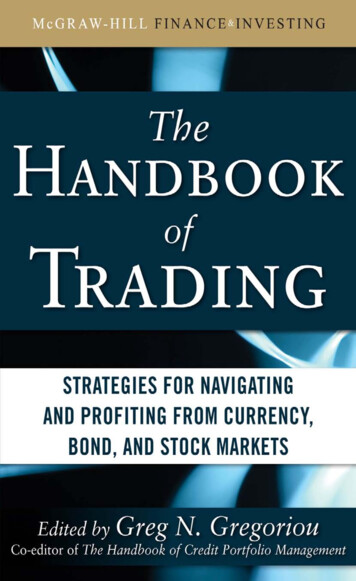
Transcription
THE GNOSTICHANDBOOKInstitute forGnostic Studies(now Defunct)
the GnosticHandbookTABLE OF CONTENTSIntroduction1First Principles2The Origin of Matter3Worlds and Planes4The Conflict between Matter and Spirit5The Gnostic Identity Message6Dominions and Principalities7The Nature of Man8The Truth about Immortality9The Mysteries of Rebirth10The Secret Way11The Secret of the Seven Churches12Revisioning Scripture13A Modern Gnostic Ecclesia
IntroductionWe at the Gnostic Apostolic Church have felt for many years that there is a great need fora study of the principles on which the Gnostic tradition is built. At first we avoided sucha task as our knowledge of the Gnostic tradition was still evolving and because anyoutline of religious symbology can come across as dogmatic and doctrinal. However, astime progressed we realised that if we waited until all the facts were in and we worked toavoid misconception, we would end up with the Gnostic Handbook never being written.Accordingly, we believe that within this handbook is a comprehensive summary of thebasic principles of the Gnostic tradition. We realise that it stands in direct opposition towhat most of the modern Christian Churches teach today. However, we stand-fastbelieving that we have been moved by the spirit of the Pleroma to restore the originalfaith as expounded by the Apostles, and offer this work for your consideration.In recent times with the advent of fundamentalism of all forms, a clear and preciseexplanation of the ideals of Gnosticism is not only useful, but mandatory. At the onset itshould be made clear that Gnosticism is a personal experience of religion. The termGnosis means "an experience of knowledge" and religion (from the Latin Religio) means"to bind back to the point of origin" and hence Gnosticism is an experience of the realessence of what God is. It does not represent dry dogmatism or a simple recital of facts,but a real and personal experience of God within human experience. It is in this spirit weissue this handbook. The structure of this handbook is aimed to facilitate easy access ofinformation on basic religious questions. This is not meant to be an exhaustive theological exposition but a summary of the teachings which embody the Gnostic legacy whichhas been passed onto the Gnostic Apostolic Church. The approach we have taken in thishandbook has been a religious one, our primary source of symbolism has come fromwithin the Essene, Valentinian, Zoroastrian and Christian Gnostic traditions. Otherinterpretations are certainly possible and for those who wish to get “behind” the symbols,interpretations and beliefs we suggest you study the various publications and coursesissued by the Institute for Gnostic Studies.We hope you will find the Gnostic Handbook edifying as well as enjoyable reading.
The Gnostic Handbook Page 5Algebra, Gnosis and ReligionAlgebra is a branch of mathematics that uses letters etc to representnumbers and quantities. Algebraic is ultimately from Arabic Al-Jabr –reunion of broken parts.Pocket Oxford Dictionary.It may be thought that Algebra has little similarity to religion, however, if weconsider it more closely they have much in common. Algebra uses letters torepresent actions and numbers, it is a system of representation and in a sense,symbolism. This is also the case with religion. Religion uses symbols to stand forrealities, it uses images to represent things that cannot be easily imagined orexplained. The problem is that Algebra is an academic form of mathematics and haslittle effect on everyday life while religion controls and influences us more than wewould care to admit. Only be removing religious iconography from the realm of theemotions and appreciating it as a symbol system, as a form of divine algebra can wereally understand its nature. The Gnostic handbook is one application, one representational system for the ancient Gnosis. It can be seen in many forms and using manysymbol systems. Accordingly, it is important to realise the difference between therepresentational letter and the thing that is represented, between the essence and theform. The Gnostic Apostolic Church hence differentiates between its philosophicalworks (such as Gnostic Theurgy) and its religious works (such as the GnosticHandbook).To give an example, while all Gnostic traditions agree on the dualist nature of theuniverse, there are many divergent ways of expressing this dualism. Some Gnosticschools have two Yahwehs, a true and false creator. Others see Yahweh as the fallencreator (Demiurge) and postulate a Lord of Wisdom who is the true Creator. Whileall of these “representational” systems are divergent, their essential message is thesame. In algebraic terms while the letters vary, the numbers they represent areidentical. This should be kept in mind while studying this Handbook, it is one andone only interpretation of the essential Gnostic wisdom.The aim of using Algebra according to the Arabs was to have a better understanding
The Gnostic Handbook Page 6of the real nature of the equation, to find the essential form through the many shardsor forms. This too is the vision of the Gnosis, the Arabic meaning of Algebraic ispregnant with meaning – the reunion of broken parts.The Sources of our TraditionThe Gnostic tradition is one that has spanned Millenniums, it represents the height ofthe religious traditions of Humanity. Its primary points of focus are found withinVedic Philosophy, Zoroastrianism, Israelite Mystery traditions and Gnosticism. TheGnostic tradition is not culturally locked within the Israelite-Gnostic Christiantradition as many modern exponents seem to profess. It is a Pan-Gnostic tradition,which spans many traditions and cultural milieus. The primary assumption of theGnostic tradition is that at some point in the dim reaches of time there was a primaluniversal religion, this religion degenerated as man degenerated and remnants of itare found within the various faiths. These faiths rather than being the primary sourcesof wisdom within themselves are actually remnants of one earlier, and more pristineschool of knowledge. As time progressed the higher kingdoms saw the loss of gnosisand therefore chose to restore the structure of the Mysteries. When Jesus came to theEssenes he purified the structure of the Mystery traditions and re-instated the originalGnostic faith. Hence, the Gnosticism of Jesus is not superior to other Ariosophicfaiths, but a refinement or adaptation of an age-long tradition - together the variousAriosophic traditions offer a system applicable to modern man.These teachings, however, did not remain available forever. As society changed anda new regime came to power the teachings of Jesus were suppressed and replacedwith the political faith of Emperor Constantine, and accordingly the Gnosis wentunderground to ensure its survival. What we have in today's religious movements arenot the original forms of Judaism and Christianity, but apostate faiths masqueradingin their place. The Bible itself has been tampered with to such an extent that only byreturning to fragments of the other Aryan traditions can we restore the primal Gnosis.The Gnostic Apostolic Church upholds the original inner teachings of Jesus. Theseare a re-instatement of the original and first faith of the Pan-Aryan tribes, remnantsof which can also be found in other Aryan faiths - but are found in a more refinedform in the esoteric traditions of the early Gnostics.
The Gnostic Handbook Page 7But it is perhaps desirable to state unequivocally that the teachings here,however, fragmentary and incomplete belong neither to the Hindu's, theZoroastrian, the Chaldean, nor the Egyptian Religion, nor to Buddhism,Islam, Judaism or Christianity exclusively. The Secret doctrine is theessence of all these.The Secret Doctrine,Madame Blavaskty.Behind the veil of all the hieratic and mystical allegories of ancientdoctrines, behind the darkness and strange ordeals of all initiations,under the deal of all sacred writings, in the ruins of Nineveh or Thebes,on the crumbling stones of old temples and on the blackened visage ofthe Assyrian or Egyptian Sphinx, in the monstrous or marvellouspaintings which interpret to the faithful of India the inspired pages of theVedas, in the cryptic emblems of our old books on alchemy, in theceremonies practised at receptions of all secret societies, there are foundindications of a doctrine which is everywhere the same and everywherecarefully concealed.the key of all divine obscurities and the absolutequeen of society in those ages when it was reserved exclusively for theeducation of priests and kings.Transcendental Magic,Eliphas Levi.
The Gnostic Handbook Page 8Chapter OneFirst PrinciplesWho is the Lord of Wisdom ?One of the central issues within any religious tradition is who or what is God ? Inmany early Aryan faiths there is clear definition of God though this may be expressedthrough many diverse images and language forms. These definitions while divergentin form, have one thing in common, they all define God without the using descriptions in moral or ethical terms. God simply Is. In some sense this is central to theGnostic understanding of God for he/she/it is beyond definition, to define God in anyway, is in some sense, to limit he/she/it. For the Saivite Hindu, for example, thesupreme deity is defined as Shiva with Brahma and Vishnu simply being modes orpersonas. While in other traditions, Brahman or Vishnu is supreme with the otherdeities being modes of its expression. In each case, there is still a further moretranscendent form, the Parabrahm (or ParaVishnu/Shiva), each being defined asbeyond definition with the traditions of divine activities being relegated to the lesserforms or manifestations or interpreted in an allegorical fashion.In the Zoroastrian faith titles such as Ahura Mazda are superlative definitions of afirst cause, while in the later derivative Mithraic faith God was defined as Zurvan orthe Lord of Time, since fate or time was believed to be the principle which is beyondall things. For the Gnostic, God simply IS. He/she/it is the one source beyond andbehind all things, in both the Zoroastrian and Israelite faiths God is usually simplycalled Lord as this designates a title of respect for a superior. For us, s/he is the Lordof Wisdom.What’s in a name ?The issue of the name of God is an important one, for in some sense to givesomething a name is to define it. For Medieval sorcerers to know the name of a spiritwas to control it. In the Gnostic tradition we understand the frailty of the humanspirit and the desire to project humanity onto divinity, this tendency towards
The Gnostic Handbook Page 9anthropomorphism is a dangerous one. Since man is fallen and matter is in a state ofdecay, to project humanity onto divinity is to, by necessity, bring divinity down to ahuman level. While certainly images, legends, myths and Godnames have their place,their value is in what they represent rather than in themselves. In regards to thename(s) of God in the Old Testament there is a real quandary, there are many namesfor God, though translated under the one title in English. What makes it moredifficult is that each name has a different meaning, the name Elohim, for example,means Mighty Ones (note it is plural) and can be applied to any form of demi-god,destructive or constructive, of the light or of darkness.Generally speaking, the use of the term Elohim in the Old Testament tends to hidethe fact that the beings who are communicating are fallen Archons or worse still, thefalse creator masquerading as forces of light. The same applies to the formula ofYHVH, while it has a esoteric meaning, it too, has been twisted to reflect thebarbaric and violent storm God that is falsely represented throughout the OldTestament as the creator. For these reasons Gnostics tend to avoid the Old Testament names of God altogether and identify the Old Testament Yahweh and Elohimwith Ialdoboath, the false Archon who brought about the creation of fallen matter.The PleromaThe Lord of Wisdom is the title we use for the source of all light, the UnoriginateOriginator. However, the Lord of Wisdom does not exist alone, throughout timehe/she/it expands and contracts filing the spiritual dimensions with luminous beingsof all orders and forms. In the Valentinan hierarchy, for example, there are eightmajor forms (Aeons) and twenty two minor, in the Kabbalah there are ten majorSephiroth and twenty two paths. The processes by which these realities are createdare complex and vary from tradition to tradition. Each of these interpretations can befurther expanded to include a whole universe of luminous realities, from the highestforces or Aeons to choirs and angels.Traditionally this complete spiritual kingdom is known as the Pleroma or fullness,because it is filled to the brim with light and life. At the same time, the major spiritualforces within it are known as Aeons. While in the Gnostic tradition we tend toemphasise the two principles, Logos and Sophia and the Seven Spirits or Aeons,
The Gnostic Handbook Page 10there is a universe of created beings which exist in the Pleroma and which fulfil thecreative directive expressed by the Lord of Wisdom. In one Gnostic tradition, Michael(as a manifestation of the Logos Ray) and first estate predecessor of Jesus, was thefirst created immortal.The Two Principles: The Logos and SophiaEmanating from the Lord of Wisdom and through the Pleroma are two currents, theseare known as Logos and Sophia. The Logos is the mind of the Lord of Wisdom, theSophia is the intuition. These two currents form the manifestation of the Lord ofWisdom into the higher worlds. (See Fig 1). There are many hierarchical locations forthese two principles, for example, Valentinus sees the Logos as the first created form(Barbelo), while Sophia is the last emanated Aeon. Regardless of tradition, the Logosand Sophia play major significant roles in the Gnostic hierarchy and are hence seen asthe two principles. They should not really be seen as separate or discrete deities butas facets of the Lord of Wisdom in action. Since the Lord of Wisdom is beyonddefinition when the Lord initiates activity, results take place through the various facetsof his being and via a hierarchy or dynasty of forces and forms. The two mostimportant of these are the Logos and Sophia. The Logos is known as Spenta Mainyuin the Zoroastrian tradition and is the Mind of the Lord of Wisdom in action, inmythology this facet of the Lord is known as his first son.Fig 1Fig 2Lord of WisdomLord of WisdomLogosLogosSophiaSophiaAeonsThe Immortals
The Gnostic Handbook Page 11What are the Aeons ?According to the Gnostic traditions these two forces further manifest through a seriesof forms or entities. These forms can be expressed in many different ways, the mosttraditional is to know them as Aeons, while in Egypt they would have been calledSacred Principles or Neters. In the Zoroastrian tradition they are known as the HolySpirits (Spenta Amesha). (These are akin to the Seven Spirits before the Throne in theBook of Revelation). These forces can, in some sense, be even understood as theseven aspects of The Lord of Wisdom. This links interestingly with some westerntraditions, which see the Seven Spirits before the throne (Revelation 4:5) as sevenphases of the Holy Ghost. These Aeons or spirits have many different aspects andfacets. They work against the fallen Archons to awaken mankind and in every age theyreveal a different mystery and gnosis to awaken slumbering humanity. They may alsobe related to the Seven Rays of the Theosophical and Rosicrucian Mystery traditions.In the heavenly hierarchy these spirits are again emanations from the Lord of Wisdom,they have no separate existence. Under them are formed the Immortals, beings thatembody each ray or spirit. (See Fig 2 & 3).And out of the throne proceeded lightning and thundering and voices: andthere were seven lamps of fire burning before the throne, which are theseven Spirits of God.Revelation 4:5The Seven Spirits1.2.3.4.5.6.7.Khshathra VairyaHaurvatatSpenta ArmaitiAmeretatVohu ManahAsha VahishtaSpenta MainyuDesirable Power, The Kingdom of GodWholeness, HealthHoly Piety, DevotionLong life, ImmortalityGood purpose, good thoughtBest, Right, Truth, OrderThe Holy OneFig 3
The Gnostic Handbook Page 12Jesus as the First-born of CreationOne of the major debates in Christianity has been about the nature of Jesus, whilemany traditions emphasise monotheism others border on polytheism or offer strangecombinations of belief in such forms as the trinity. Since many of the early Aryanreligions such as the Israelite Mystery tradition, the Vedic and the Zoroastrianemphasised that God is a unity, there seems to be a contradiction between this andthe supposed incarnation of Christ. However, when we examine the New Testamentin a critical manner some important facts come to light. Jesus over and over againclaimed to be the Messiah and the Son of God, but not God himself. He prayed tothe Father and spoke of God as a separate entity to whom he was obedient. In theGospel of John the identity of Jesus is the central theme, the aim of this Gospel is toshow the reader that Jesus is the Messiah, the Son of God, not God the Son (John21:31). While John himself clearly tells us that Jesus distinguished himself from thefather who is the "Only one God" (John 17;3, 5:44, 6:27). We also find St.Paulclearly describing Jesus as the first-born of every creature and the firstborn of thedead (Col 1:13,15,18). This is echoed in the Book of Revelation where we read thatJesus is the "Beginning of the Creation of God". Over and over again we findnothing of Jesus being God or even equal with God. Jesus is clearly the firstborn ofcreation, the first created being. Jesus is the messenger of the Pleroma whose fatheris the Lord of Wisdom and whose enemy is the false creator of the Old Testament.Jesus, Christ and LogosWhen we come to understand that Jesus is a created being a new picture of divinityarises. Jesus was the first created being, Michael, the first of the immortals createdthrough the power of the Logos. There is one Source of light, the Lord of Wisdomand other created beings formed by the force of the divine mind. Jesus in the firstestate (before coming into a physical body) is Michael, that immortal who playssuch an important role in the Cosmic battle we will discuss later. When Michael isborn into the Essene community, he becomes Jesus. At his Baptism, after years oftraining (the so-called Lost years) he became the Christ. His special Essene traininghad involved processes that cleansed the human state by the power of Sophia andtransformed his bodily vehicle into a form that was made pure enough for the fullmanifestation of the Logos. Jesus as an individual, discrete being (Michael) still
The Gnostic Handbook Page 13existed but communed with the Logos within him. Jesus was not and is not God or theLogos or Christ, he became Christed and hence in that understanding is known asJesus the Christ. The term Christ means "anointed" and refers to the state of sonshipto the Lord of Wisdom. Jesus at his baptism communed with the Mind of God(Logos), his actions came to embody the Spirit of God (Sophia) and he became a fullson of God (Christ).We speak of God, of the Son, his Word, and of the Holy Spirit and wesay that the Father, the Son and the Spirit are united in power. For theSon is the intelligence, reason and wisdom of the Father and the Spirit isan effluence, as light from fire. In the same way we recognise that thereare other powers which surround matter and pervade it.AthenagorasGenerally speaking the ancient Gnostics primarily viewed Christ as aneternal, celestial power, the Logos with which it is possible to have anintimate, personal relation, since our higher consciousness is made in itsimage. For this reason, Gnostics stressed the experience union with thedivine and showed little interest in the historical Jesus, whom it hasalways been impossible to know in a concrete sense or even accuratelyin a historical sense.Jesus Christ, Sun of God.David Fideler,Quest Books. 1993.The state of Christhood is a state to which all of us must aim, it is the state by whichwe return to the Pleroma. The Logos and Sophia as energy fields from the Lord ofWisdom emanate into the fallen world and if permitted will transform us into immortalbeings. This teaching is The Solar Tradition and is central to our understanding of theGnosis. We will return to it in some detail later.
The Gnostic Handbook Page 14What is Sophia ?A major contention in Christian theology has always existed over the nature of theHoly Spirit. In modern thought the Holy Spirit is seen as the third person of a Trinity,however, from historical evidence we find that this belief only dates from the time ofthe Nicean creed. Generally speaking the term Spirit in the New Testament (John14:26) is neuter, the use of male pronouns in relation to this term rather than referringto a deity tends to refer to the process of personification used in the Bible. Forexample, in the Old Testament (Psalm 96:11,12) we have fields, trees, hills etc. allpersonified with the same pronoun, hence the term is used more in the sense ofpersonification. In the writings of St.Paul we read a lot about the Father and the roleof Christ, but nothing of the action of a third party. For example, in 1 Corinthians3:23 we read that Christians are said to belong to Christ as he belongs to the father,but no mention is made of us also belonging to the supposed third member of theTrinity. Throughout St.Paul's writing we find reference to Christ and his relationshipto the Father, but nothing intimating a Trinity role for the Holy Spirit.The general understanding of the Holy Spirit as found in the Gnostic tradition is thatit is the power of the Lord of Wisdom, it is personified in the same way we maydescribe the power of a entity, however, it has no individuality per see. It is the Lordof Wisdom in action, akin to the Logos being the Mind of the Lord. At the same timehowever there is an important Old Testament tradition which sees the Holy Spirit asWisdom (Sophia) and hence identifies it as feminine. To fully appreciate this weneed to dig below the surface to gain a special understanding of the Godhead. TheFather is gender-variant in the human sense but is obviously (Logos and Sophia),passive and active in nature. Hence, the Lord of Wisdom is seen as androgynous.While at the same time the Logos and Sophia are different facets of the Lord ofWisdom as active in the higher and lower worlds. The Logos is active andcharacterised as masculine beacause it functions as the the analysing mind, while theHoly Spirit is his power in Action and is seen as feminine. These powers do have, inactuality, personality but not individuality, as they are personas of the Lord ofWisdom. Hence, the Holy Spirit is a feminine energy of God. To fully appreciate thiswe need to consider the iconography of Sophia.
The Gnostic Handbook Page 15The Nature of SophiaThis is an important question for it brings to mind all the issues regarding religionand gender. The simple answer is that the Lord of Wisdom, being beyond humanity,is androgynous, or probably more correctly, beyond gender. Though the male imageis used in the Bible there is no strict gender imperative in relation to who God is. TheOld testament is comprised of religious iconography and legends notGnostic fact, its views on God aretwisted beyond recognition and it sometimes talks about the Lord of Wisdom, sometimes about the Archon Yahweh and it is difficult to tell oneaccount from another. Accordingly itsadvice on God it not that usefulwithout some Gnostic understandingfirst. We can appreciate thatsince The Lord of Wisdom was seen interms of creative activity thereis a general personification of him asMale, but this can only rightlybe interpreted as imagery and iconography, not reality. Whenwe consider humans, regardlessof sex, can return to thePleroma, then we realise thatsex bias is non-existentin the Gnostic tradition. Oneof the most unique traditions in regards to the natureof the Holy Spirit is thetradition of Sophia, the Goddess of Wisdom. This is atradition of great age and somebeauty that personifies thepower of the Holy Spirit asdistinctly female. For example, in Proverbs particularly we have Sophia wanderingthe street begging men to love her. While in the following quotes we may even beginto think that Sophia or Wisdom is separate, yet in reality, Sophia is a facet of theLord of Wisdom himself.Wisdom crieth without; she uttereth her voice in the streets: She criethin the chief place of concourse, in the openings of the gates: in the cityshe uttereth her words, saying, How long, ye simple ones, will ye lovesimplicity? and the scorners delight in their scorning, and fools hateknowledge?Turn you at my reproof: behold, I will pour out my spirit unto you, I willmake known my words unto you. Because I have called, and ye refused;I have stretched out my hand, and no man regarded; But ye have set at
The Gnostic Handbook Page 16nought all my counsel, and would none of my reproof: I also will laughat your calamity; I will mock when your fear cometh; When your fearcometh as desolation, and your destruction cometh as a whirlwind;when distress and anguish cometh upon you. Then shall they call uponme, but I will not answer; they shall seek me early, but they shall notfind me: For that they hated knowledge, and did not choose the fear ofthe LORD:They would none of my counsel: they despised all myreproof. Therefore shall they eat of the fruit of their own way, and befilled with their own devices.For the turning away of the simple shall slay them, and the prosperity offools shall destroy them. But whoso hearkeneth unto me shall dwellsafely, and shall be quiet from fear of evil. The LORD possessed me inthe beginning of his way, before his works of old.When he preparedthe heavens, I was there: when he set a compass upon the face of thedepth: When he established the clouds above: when he strengthened thefountains of the deep: When he gave to the sea his decree, that thewaters should not pass his commandment: when he appointed thefoundations of the earth: Then I was by him, as one brought up withhim: and I was daily his delight, rejoicing always before him.Proverbs 1:20-33, 8:22,27-30.Sophia, hence, should not be understood as a distinct deity. We need to understandSophia in context and see Sophia as a strong personification of the impersonal powerof the Lord of Wisdom. As the Logos is male and creative in activity, Sophia ispassive and feminine. In some traditions, specifically found within the RussianOrthodox traditions (and many pagan faiths), Sophia's symbolism is even furtherdeveloped, these images are relevant for the Gnostic and can certainly offer a deeperand more mystical understanding of the nature of the Holy Spirit if understood withinthe context of the Gnostic view of the Godhood, by themselves they are reduced tothe more malefic forms of earth and goddess worship.This great being, both royal and feminine, who being neither God northe Eternal Son of God, neither angel nor saint, receives the venerationof the One who accomplishes the Old Testament, as well of the One
The Gnostic Handbook Page 17who is the begetter of the New Testament; who is she, then, but thetruest humanity, the purest and most whole of beings, the macrocosmicwhole, the living soul of nature and of the universe eternally united anduniting in the process of time with the divine and uniting all that is.The Pillar and Foundation of the Truth,Pavel Florensky.The importance of Sophia can be best understood when we understand the primalmyth behind her nature. Throughout many cultures there has been the legend of theGoddess who is stolen from the world of life and is taken to the underworld. Thereshe is kept captive pinning for her lover who is still in the other world. She waits andpines until at last some salvation is achieved by her hero coming into the underworldto save her. However, this salvation is at a cost and together they end in a battleagainst the underworld until the completion of the tale. Though there are manymodifications of this tale, it is the story of the spark of God within man. Mans trueself is caught in the coils of earth and is lost in the consciousness of matter. Thenature of the spirit-spark within man is that of being a seed, God in potential. InHebrew it is called the Ruach and interestingly, one definition offered of the Ruachis Sophia. So, here we have an Israelite version of the classic tale. The spirit of Godin man is a spark, a seed of Light, it is caught in matter and crying out for Salvation.The Logos embodied in Jesus answers the call and through great suffering offerssalvation. But it is not that simple, for while Sophia still lives in the world system,she can only travel to the upperworld by day and must return to the underworld bynight or so the legend goes.So man, on the Path of Transfiguration, though being reborn through the powers ofthe Lord of Wisdom must live in the world, but try not to be of it. Sophia henceoffers us some fascinating insights into the nature of God. She is the Daughter of TheLord of Wisdom and yet is the Lord himself, the Spouse and Lover of the Logos andthe Spirit within Man. She is reflected in the light hidden in nature, the Ecclesia, theGnostic Scripture and Man, and illustrates the presence of light in all things.In each of these things Sophia manifests the Lord of Wisdom. In the material worldSophia is the presence of God in nature. Even after the fall of man, nature still
The Gnostic Handbook Page 18exhibits the divine spark, though its lustre has been sorely diminished. Nature isfallen and degenerated, granted, but it fell according to the archetypal pattern ofspirit on
The Secret doctrine is the essence of all these. The Secret Doctrine, Madame Blavaskty. Behind the veil of all the hieratic and mystical allegories of ancient doctrines, behind the darkness

